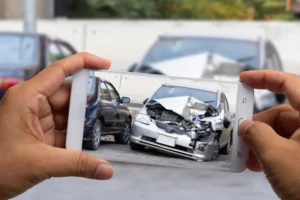Tips for Taking Photos of a Car Accident Scene~2 min read
If you are in an accident with another vehicle, photos you may be able to take at the scene may help your case if you claim the other driver was at fault. At Springer & Lyle, we have some tips for you when photographing the accident scene.
Tips for Photographing an Accident Scene
Most people have a phone with a camera. Taking photos at the scene can limit your own liability, protect you against fraud, and help you prove who was at fault. Some photographing tips include:

- If possible, take photos before the vehicles are moved.
- Protect yourself. Don’t risk danger and be sure you take a position such that you won’t get hit by another vehicle while photographing.
- Take distance photos of the entire scene, then move closer to the vehicle, taking pictures as you move forward.
- In addition to photographing the scene and the positions of the cars, take photographs of road conditions, focusing on potholes, debris, and road sign obstructions.
- Photograph skid marks or other tire marks left on the roadway or adjoining pavement or dirt area.
- Take photos of traffic control signals and signs, or of their absence if that seems relevant.
- Take photos of the inside of vehicles if possible, including headsets, cell phones, bottles, and cans.
- Take photos of the vehicle you collided with. Stand about 10 feet away so you have a good view and range.
- If occupants of the vehicle you collided with do not appear injured, take photos, or short videos of them and what they are doing.
- Take photos of your vehicles with a view from each corner of the vehicle.
- Photograph license plates and any unique markings or signs on vehicles, including those driven by witnesses who refuse to identify themselves or give you contact information.
- Don’t take graphic photos of injuries or fatalities.
- Don’t share your camera with any other person at the scene unless it is someone you know and trust or your own insurance representative.
- Take photos of anything in the area that you think may be relevant. It is better to have photos you do not need than to wish later you had taken a photo of something.
You may be nervous or shaking from the shock of the accident. If you believe you cannot take the photos, ask someone who was with you or someone you trust to take the photos. Do not share your camera with the other driver or occupants of the other car.
Contact Springer & Lyle for Assistance
The personal injury attorneys at Springer & Lyle have been helping victims of negligence for over 30 years. Call 940.370.4033 for a free consultation.





